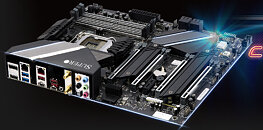Monday, May 11th 2020
Supermicro Outs Z490 LGA1200 SUPERO Pro Gaming C9Z490-PGW Motherboard with Dual x16 PCIe
Server motherboard specialist Supermicro has been taking steps into the client-segment for a couple of years now under its SUPERO brand. Its latest creation is a socket LGA1200 motherboard based on the Intel Z490 chipset, the Pro Gaming C9Z490-PGW. There isn't too much bling or color, except some contemporary design cues such as the rear I/O shroud, and diagonal accents on the PCH and M.2 heatsinks. The feature-set of this board looks like it's been drawn up by people who design enterprise boards. The board pulls power from a combination of 24-pin ATX and 8-pin EPS power connectors, conditioning it with a 12-phase "server grade" VRM. Its BIOS ROM chip is socketed. There's equal focus on U.2 as M.2.
The star attraction is the PCIe setup. The board uses a PLX PEX8747 PCI-Express gen 3.0 x48 bridge chip to drive two PCI-Express 3.0 x16 slots at full x16 bandwidth, which can split between four slots in x8/x8/x8/x8 configuration when all of them are populated. Storage connectivity includes one each of M.2-2280 and M.2-22110 slots; two U.2 ports with 32 Gbps wiring; and four SATA 6 Gbps ports. Networking options include a 10 GbE interface pulled by an Aquantia AQC107 controller, a second Intel i219-V PHY handling a 1 GbE port, and 802.11ax + Bluetooth 5 wireless connectivity provided by an Intel AX201 module. USB connectivity includes four 10 Gbps USB 3.2 gen 2 ports, and six 5 Gbps gen 1 ports. The onboard audio setup features a high-grade Realtek ALC1220 codec. The company didn't reveal pricing.
The star attraction is the PCIe setup. The board uses a PLX PEX8747 PCI-Express gen 3.0 x48 bridge chip to drive two PCI-Express 3.0 x16 slots at full x16 bandwidth, which can split between four slots in x8/x8/x8/x8 configuration when all of them are populated. Storage connectivity includes one each of M.2-2280 and M.2-22110 slots; two U.2 ports with 32 Gbps wiring; and four SATA 6 Gbps ports. Networking options include a 10 GbE interface pulled by an Aquantia AQC107 controller, a second Intel i219-V PHY handling a 1 GbE port, and 802.11ax + Bluetooth 5 wireless connectivity provided by an Intel AX201 module. USB connectivity includes four 10 Gbps USB 3.2 gen 2 ports, and six 5 Gbps gen 1 ports. The onboard audio setup features a high-grade Realtek ALC1220 codec. The company didn't reveal pricing.


18 Comments on Supermicro Outs Z490 LGA1200 SUPERO Pro Gaming C9Z490-PGW Motherboard with Dual x16 PCIe
Reminder - using a third party PCIE switch means adding a tiny bit of latency
Reminder 2 - this old switch only supports 3.0 version of the spec
I could see this board used for ML rigs, as at X8 communication for most types of algorithm techniques remain at top speed.
The cooler face plate at most cases.
If you haven't had such problem, good for you but that is normal, becase seldom any mobo maker does something like that unless it is OEM or server. SLI users more often got issues with that with the more bottom slots.
For upper PCIe slot design, having something there is a bad and unusual design practice in the first place for consumer boards.
That is what you get from guys wo are used to designing blade server parts.
and i think the angle we look at is off so it looks taller.
maybe its not higher then the m2 metal plate
is this really a cooler for intel lan chip same on z390 mobo?
I've never had any issue with Gigabyte or ASUS graphics card having too thick backplate or anything else interfering with motherboard components (other than mentioned IO covers).
If your setup is fine, leave it be, but you have no point to defend it only because you have it in you shelf, as it could be a unusual flaw for many system builders, I am not the only one having stumbled on such issues during past years exactly on such funky design motherboards.